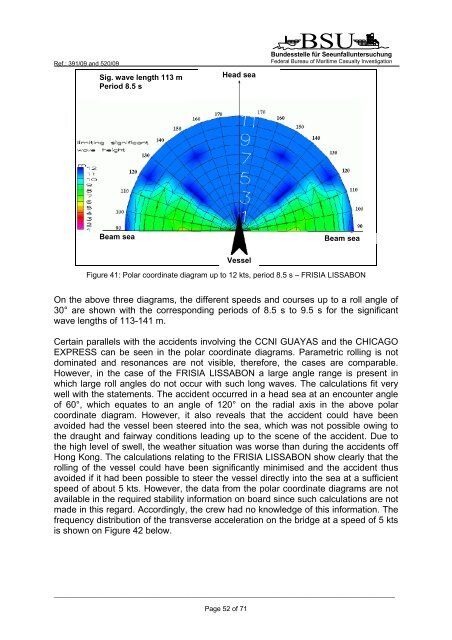SUB-COMMITTEE ON STABILITY AND LOAD LINES AND ON ...
SUB-COMMITTEE ON STABILITY AND LOAD LINES AND ON ...
SUB-COMMITTEE ON STABILITY AND LOAD LINES AND ON ...
You also want an ePaper? Increase the reach of your titles
YUMPU automatically turns print PDFs into web optimized ePapers that Google loves.
Ref.: 391/09 and 520/09<br />
Sig. wave length 113 m<br />
Period 8.5 s<br />
Head sea<br />
BSU<br />
Bundesstelle für Seeunfalluntersuchung<br />
Federal Bureau of Maritime Casualty Investigation<br />
Beam sea<br />
Beam sea<br />
Vessel<br />
Figure 41: Polar coordinate diagram up to 12 kts, period 8.5 s – FRISIA LISSAB<strong>ON</strong><br />
On the above three diagrams, the different speeds and courses up to a roll angle of<br />
30° are shown with the corresponding periods of 8.5 s to 9.5 s for the significant<br />
wave lengths of 113-141 m.<br />
Certain parallels with the accidents involving the CCNI GUAYAS and the CHICAGO<br />
EXPRESS can be seen in the polar coordinate diagrams. Parametric rolling is not<br />
dominated and resonances are not visible, therefore, the cases are comparable.<br />
However, in the case of the FRISIA LISSAB<strong>ON</strong> a large angle range is present in<br />
which large roll angles do not occur with such long waves. The calculations fit very<br />
well with the statements. The accident occurred in a head sea at an encounter angle<br />
of 60°, which equates to an angle of 120° on the radial axis in the above polar<br />
coordinate diagram. However, it also reveals that the accident could have been<br />
avoided had the vessel been steered into the sea, which was not possible owing to<br />
the draught and fairway conditions leading up to the scene of the accident. Due to<br />
the high level of swell, the weather situation was worse than during the accidents off<br />
Hong Kong. The calculations relating to the FRISIA LISSAB<strong>ON</strong> show clearly that the<br />
rolling of the vessel could have been significantly minimised and the accident thus<br />
avoided if it had been possible to steer the vessel directly into the sea at a sufficient<br />
speed of about 5 kts. However, the data from the polar coordinate diagrams are not<br />
available in the required stability information on board since such calculations are not<br />
made in this regard. Accordingly, the crew had no knowledge of this information. The<br />
frequency distribution of the transverse acceleration on the bridge at a speed of 5 kts<br />
is shown on Figure 42 below.<br />
_____________________________________________________________________________________________________<br />
Page 52 of 71
















